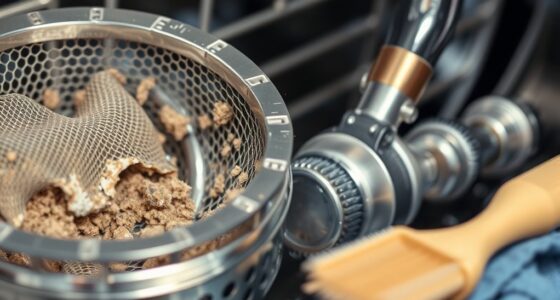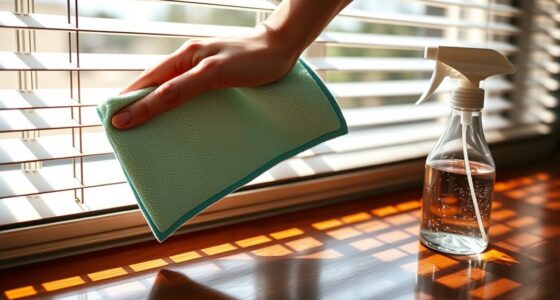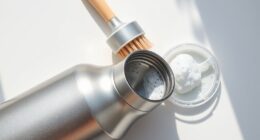To remove paint splatters from floors, start by identifying if the paint is water-based or oil-based. Use a plastic scraper or credit card to gently lift excess paint, then dampen a cloth with warm water and mild soap to loosen remaining spots. For stubborn paint, consider a paint remover or mineral spirits—always test first and make certain good ventilation. After cleaning, wipe the area with a damp cloth and dry thoroughly. Keep safe and follow proper disposal guidelines; if you keep going, you’ll learn even more effective tips.
Key Takeaways
- Identify the paint type (water-based or oil-based) to choose appropriate removal methods.
- Gently scrape excess paint with a plastic scraper or credit card without damaging the floor.
- Use warm water and mild soap for water-based paint or apply a suitable chemical remover for oil-based paint.
- Test cleaning solutions on a small area first to prevent surface damage.
- Clean thoroughly and dry the area to prevent residue buildup and potential floor damage.

Accidents happen, and paint splatters on your floors can quickly turn into a stubborn mess. When you find yourself in this situation, it’s vital to act carefully and efficiently. Knowing the right paint removal techniques can save you time and prevent damage to your flooring. Before you start, make sure to prioritize cleaning safety tips—wear gloves, ventilate the area, and avoid inhaling fumes or letting harsh chemicals contact your skin. Safety first helps you handle the cleanup process without unnecessary risks.
First, assess the type of paint you’re dealing with. Water-based paints are generally easier to remove than oil-based ones. For water-based splatters, start by gently scraping off excess paint with a plastic scraper or a credit card. Be careful not to scratch or gouge the surface. Once you remove as much as possible, dampen a clean cloth with warm water and a few drops of mild dish soap. Gently blot the affected area to loosen the remaining paint. For stubborn spots, consider using a soft-bristled brush to scrub gently. Rinse the cloth frequently and change the water as needed to avoid spreading the paint. Recognizing the type of paint beforehand can help you choose the most effective removal method.
If the paint is oil-based or stubborn, you may need stronger paint removal techniques. Commercial paint removers or mineral spirits can be effective, but always read the label and follow the manufacturer’s instructions closely. Before applying any chemical, test it on a small, inconspicuous area to guarantee it won’t damage your flooring. When using chemical paint removers, ensure good ventilation, wear gloves, and avoid inhaling fumes. Apply the remover with a cloth or sponge, allowing it to sit for the recommended time, then gently scrub the area with a soft brush or cloth. Wipe away residue with a damp cloth afterward, and thoroughly dry the surface.
In all cases, after removing the paint, it’s wise to clean the area with a mild cleaning solution to remove any leftover chemicals. Proper disposal of used rags and containers is vital for safety. Keep pets and children away from the area until it’s fully dry and clean. Remember, patience is key—rushing may damage your floor or leave remnants behind. When you follow these paint removal techniques and adhere to cleaning safety tips, you’ll restore your floors efficiently and safely, avoiding costly repairs or replacements later on.
Frequently Asked Questions
Can Paint Splatters Damage My Floor’s Finish?
Paint splatters can damage your floor’s finish if not cleaned promptly, especially on unprotected surfaces. They may cause discoloration or absorption if the paint seeps into porous materials. To prevent this, use floor protection like drop cloths or plastic sheeting, and clean splatters quickly before they set. Regular maintenance and careful painting practices help preserve your floor’s beauty and prevent long-term damage.
Are There Eco-Friendly Paint Removal Options?
Eco-friendly paint removal options are like gentle giants, effective yet kind to the environment. You can use biodegradable solvents, which break down naturally without harming ecosystems, or natural cleaning agents like vinegar or baking soda. These options are safe, non-toxic, and work well on paint splatters. By choosing eco-friendly methods, you safeguard your floors and contribute to a healthier planet. Always test first to ensure they won’t damage your surface.
How Long Should I Wait Before Cleaning Fresh Splatters?
You should wait until the paint has a proper dry time and curing period before cleaning fresh splatters. Typically, this means waiting at least 24 hours for water-based paints and up to several days for oil-based paints. Rushing to clean too soon can smudge or spread the paint. Check the paint’s instructions for specific dry and curing times, and only clean once it’s fully set to avoid smearing.
Will Using Heat Help Remove Stubborn Paint?
Using heat application can help remove stubborn paint by melting it, making it easier to scrape or wipe away. You might use a heat gun or hairdryer to gently warm the paint, but be careful not to damage the floor surface. The heat softens the paint, allowing for smoother removal. Always test a small area first, and work slowly to avoid any surface damage or safety hazards.
Can I Use Household Items to Prevent Future Splatters?
Yes, you can use household remedies as preventive measures to avoid future paint splatters. For example, placing painter’s tape along edges and covering floors with drop cloths helps contain drips. Keep brushes and rollers in sealed containers when not in use, and work slowly to control splatters. These simple preventive measures, like using household items, save you time and effort in cleaning up later.
Conclusion
Now that you know how to tackle paint splatters, you’re almost ready to restore your floor’s pristine look. But beware—some stains might resist your first attempt, leaving you wondering if a hidden trick remains. Will a different solution do the job, or will you need to call in backup? Keep your tools close and your patience steady. The key to victory lies just beyond the next swipe—are you prepared to uncover the final secret?









